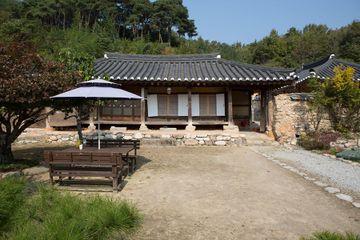"함양 우명리 정씨고가"의 두 판 사이의 차이
(→영문) |
|||
| 30번째 줄: | 30번째 줄: | ||
===영문=== | ===영문=== | ||
| + | |||
| + | This house was built by Jeong Ji-hyeon, an 8th-generation descendant of the renowned scholar Jeong Yeo-chang (1450-1504). Although, it was originally a thatched-roof house, in 1895, several of its buildings were expanded '''and roofed with tiles(?)'''. Hyori Village, where the house is located, has been home to several generations of the family ever since Jeong Ji-hyeon’s father Jeong Hui-un settled here in the 18th century. | ||
| + | |||
| + | From front to back, the house consists of a gate quarters, men’s quarters, women’s quarters, '''shrine,''' and a detached quarters. The house has a front and inner courtyard. There is a passage along the eastern side of the men’s quarters leading to the women’s quarters. The women’s quarters has a kitchen on the western side of the building and was constructed in such a way that prevents any exposure of the women’s daily activities to the outside, in accordance with the Confucian tradition of separation of the sexes. The shrine is located to the right of the women’s quarters '''on a slightly elevated ground*''' and is separated from the living area of the house with an enclosure wall. | ||
| + | |||
| + | |||
| + | * http://hamyang.grandculture.net/hamyang/toc/GC07200502#mediaview | ||
===영문 해설 내용=== | ===영문 해설 내용=== | ||
2021년 7월 5일 (월) 09:30 판
| 함양우명리정씨고가 0 |
|
 함양 우명리 정씨고가, 공공누리 |
|
| 대표명칭 | 함양우명리정씨고가 |
|---|---|
| 영문명칭 | 0 |
| 한자 | 咸陽牛鳴里鄭氏古家 |
| 주소 | 경남 함양군 수동면 효리길 6 (우명리) |
| 지정번호 | 경상남도 문화재자료 제121호 |
| 지정일 | 1985년 1월 23일 |
| 분류 | 유적건조물/주거생활/주거건축/가옥 |
| 수량/면적 | 6동 |
| 웹사이트 | 함양 우명리 정씨고가, 국가문화유산포털, 문화재청. |
|
|
|
해설문
국문
우명리 정씨 고가는 조선 전기의 대표적인 유학자로 알려진 일두 정여창(一蠹 鄭汝昌)의 7대손 희운의 다섯째 아들이 분가하여 지은 집으로서, 1895년 무렵에 안채를 비롯한 여러 건물을 증축하여 지금에 이르고 있다.
건물은 안채, 사랑채, 대문채가 앞뒤로 나란히 배치되어 있다. 건물을 배치할 때 남녀의 생활상에 따라 공간을 나누었는데, 안마당과 바깥마당이 구분되고 사랑채의 동편을 돌아서 안채에 출입하게 한 것이나 안채의 부엌은 서편에 두어 밖으로 드러나지 않게 한 것 등에서 이를 찾아볼 수 있다.
대문채가 우뚝한 것에 비해 사랑채의 규모는 작은 편이지만, 뒤편에 둔 사당은 유교 전통에 충실했던 가풍을 잘 보여주고 있다. 안채의 후면에는 별당인 세한정이 있는데, 정면 4칸에 측면 2칸의 홑처마이며 지붕은 옆면에서 볼 때 여덟 팔(八)자 모양인 팔작지붕이다.
영문
This house was built by Jeong Ji-hyeon, an 8th-generation descendant of the renowned scholar Jeong Yeo-chang (1450-1504). Although, it was originally a thatched-roof house, in 1895, several of its buildings were expanded and roofed with tiles(?). Hyori Village, where the house is located, has been home to several generations of the family ever since Jeong Ji-hyeon’s father Jeong Hui-un settled here in the 18th century.
From front to back, the house consists of a gate quarters, men’s quarters, women’s quarters, shrine, and a detached quarters. The house has a front and inner courtyard. There is a passage along the eastern side of the men’s quarters leading to the women’s quarters. The women’s quarters has a kitchen on the western side of the building and was constructed in such a way that prevents any exposure of the women’s daily activities to the outside, in accordance with the Confucian tradition of separation of the sexes. The shrine is located to the right of the women’s quarters on a slightly elevated ground* and is separated from the living area of the house with an enclosure wall.
영문 해설 내용
이 집은 조선시대의 대학자인 정여창(1450-1504)의 8대손 정지헌이 건립하였다. 처음엔 초가집으로 지었으나, 1895년에 여러 건물을 증축하여 지금의 모습을 갖추게 되었다. 이 집이 위치한 효리마을은 정지헌의 아버지인 정희운이 18세기에 입향한 후 그 후손들이 대대로 산 곳이다.
앞쪽에서부터 대문채, 사랑채, 안채, 별당이 배치되어 있다. 안마당과 바깥마당이 구분되고, 사랑채의 동편을 돌아서 안채에 출입하게 하였으며, 안채의 부엌은 서편에 두어 밖으로 드러나지 않게 하였다. 이는 남성과 여성의 공간을 구분하는 조선시대 가옥의 특징을 잘 보여준다. 사당은 안채 오른쪽에 별도의 담장으로 구분하여, 생활공간과 제향공간을 분리하였다.
문맥요소
Nodes
Links
참고자료
- 함양 우명리 정씨고가(咸陽牛鳴里鄭氏古家), 두산백과. https://www.doopedia.co.kr/doopedia/master/master.do?_method=view&MAS_IDX=101013000869297
- 함양 우명리 정씨고가, 함양박물관. https://www.hygn.go.kr/03565/03572/03576.web?amode=view&idx=181&cpage=3
- 함양 우명리 정씨고가(咸陽牛鳴里鄭氏古家), 디지털함양문화대전, 한국학중앙연구원. http://hamyang.grandculture.net/hamyang/toc/GC07200502